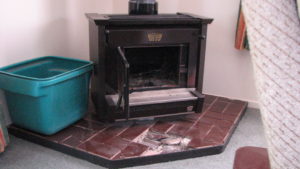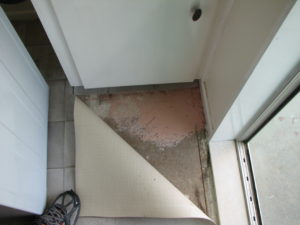My First official Building Inspection
You might well have heard the trope “Them that can’t do, teach”.
There is certainly some truth to that in my industry.
Here is my story.
I had a building business in the Waikato, we were actually doing fairly well all in all. Then I got a phone call from my brother. “Hey Bro, looking at buying a house, using the Homestart programme. Can you come and have a look at them with me?” Yeah, ok bro, only problem, I live in the Waikato, and you are in Wellington! So we bundle the kids into the trusty ol Nissan terrano, and start heading down the island. All is well until suddenly the truck doesn’t want to change gear any more in the middle of the night, halfway through the desert road. Found forth, and kept it there, thank goodness for diesel torque and a clutch to ride.
Next morning, rented a car from Palmerston North (XR6, woot) and headed on to welly.
First house of the day. A Keith Haye style hardiplank home. Fireplace install has leaked a bit.


Hearth is stuffed. But then you get to the laundry. Common evidencing spot. for low cost housing, these old boxes were pretty good really, modular, easy to work on.
But they build a subfloor, and covered it entirely with particle board. No problem typically. Except for in the bathroom, laundry, and sometimes kitchen.

That pink stuff is builders bog. Because the homes were so low cost, the laundry tub had no plumb in facility for a washing machine drain. So it drains into the sink… But then lint, cloths, nappies and plugs will almost always block the sink at some stage. Then it will fill up, with no overflow, then the particle board laundry tub starts letting water slide down its sides… then the floor gets wet. The floor typically has some covering, so you mop up as best you can, mumble about leaving stuff in the sink, and carry on with life.
First time that happens, meh, no big deal. Second time, clean it up fast, and you’ll be OK. Particle board has a wax coating. But it doesn’t last forever. Eventually it lets some water in, at least, only the stuff which doesn’t soak up the walls. The only real solution once the particle board has started to swell, is to cut it out and replace it – but walls on top of flooring make that not the easiest thing in the world to do – so in this case, they just chucked some bog over the cracked bit, threw a bit of vinyl down over top and carried on as if nothing had happened.
So for a first inspection, we could see some issues before we even got outside and under the house – like all good first home buyers, my brother wanted to spend bottom dollar, and buy a perfect home.
We looked at about 4 other properties, and then he purchased a completely different one in Wainuiomata anyway.
It was when I got home, and went through what I had that I realised not so much what I had found, as what I had potentially missed. Why? Well, I didn’t really have a system. Sure, I was a builder, I knew what went into these things, but building a house over many months, versus intimately examining a house in an hour or two – well, there is a lot that can be missed!
I went home, dug the gorse out of my pockets – popped out my credit card and brought my own copy of NZS 4306:2005
Poor old Terrano died that weekend at 435,000km, but I was so busy running through my house, trying to come up with a better, foolproof inspection methodology, that I didn’t really care.
What goes into a prosperbuild report?
We have to start with a huge helping of Love… Sigh, sounds lame, but actually, the reason I do this, I love people, and I am pretty darn keen on houses as well. But I confess, to a torrid love affair with data. I didn’t start life as a builder or quantity surveyor, I started as a computer nerd. An HTML jockey. Not a great one, but good enough to see some things computers are better at doing than humans.
Repetitive processes? Choose the computer.
Natural language? making a point, and getting it to stick, making yourself understood: Choose the Human! (yes, I know, natural language algorithms are a thing, but as of my last test, not quite there yet!)
So there are a few easy approaches to building inspections.
- You can build yourself a nice modified locked spreadsheet, and fill out autotext fields until the cows come home. If you do it right, you can theoretically inspect a house, sit in the car for half an hour, and press send. Job done. Easy money. Right? That would be a brilliant approach – if it only allowed for variation in fit and purpose. Believe me, the requirements for you, are unique. Glorified checksheets can’t yet do that justice.
- Another option is “Exception reporting”. You could conceivably pay an awful lot of money for a report which says “The house is fine”. That isn’t very helpful though.
- Long form! Yay, 250 photographs, with excruciating comment on each point. This is the way most building inspectors go, heck, when I started, that its what I did… but Technology? Design? User Experience (UX)?
I believe in customer lead methodology.
A professional couple came to me when I was still running a building company. They purchased a lovely house, and wanted to modify it to better suit their lifestyle. They gave me the building inspection they had relied on when buying. It was very expensive, and by crikey was it thorough, but… it was 98 flipping pages long!!
Mark Twain famously penned this line “I’d have written a shorter letter, if only I had more time”.
I asked the obvious question. “Have you guys read this?”
Crickets…. Chirrup chirrup. The answer came, slowly, quietly and reluctantly. “No”.
Now in theory, their lawyer was obligated to read it. On a whim while writing this article, I just completed an online reading test. When I am reading a lot, I have tested north of 900 words per minute with 90+ percent retention, but ad hoc, reading at a computer screen in my chilly office, here is my result. 639 Words per minute with 75% comprehension. The average typist can bust 120 to 150 words per minute (excluding formulation time). The average reading speed is about 200 words per minute.
Now, 20 odd pages of the report were just forms. But that leaves 78 pages, probably 200 words per page on average. In theory, it would have taken 2 hours and 10 minutes to read that. What does a lawyer charge as an hourly rate? How valuable is your time when you are under stress, negotiating a purchase, planning how to move everyone and everything, while still working and trying to get a million things under control? Can you really drop 2 hours on reading a report, and risk missing the critical 25%?… Oh boy. I don’t see that as valuable.
So what to do about it?
I put myself in my customers shoes. I asked myself “Why do people get building inspections? Who has to see the building inspection? I asked my clients questions. What are you hoping to learn? Do you want excruciating detail, or just an overview? Are you one of these people that will give DIY a shot, or do you call in tradies?
I got my hands on every single insurance on-boarding document I could. (Medical Assurance Society, I am impressed. You guys really want to know what you are going to insure!)
I talked to lawyers – “What do you need to see? How can I make the process easier for you?”
And then I started modifying my report outline.
I realised a critical fact. A matrix is a very good way of conveying a LOT of data, while taking up next to no space.
Front pages are where you expect to find a synopsis, an overview, a one glance tell tale sign – what is this property all about!
So I did something inconceivable within the stubbornly backwards building industry. I changed my method. You see, in the last 200 building inspection I have done, I have only had 1 person ask me for a printed copy. So, like the above text, I can use hyperlinks to give deeper understanding, if it is desired. I wear a video camera, and, with 2 exceptions in the last hundred inspections (dang hardware fault on my camera!), I video the whole inspection, so you can be right there with me, seeing what I see. You can hear how I would go about rectifying problems. Because I have asked you a good few questions, and gotten to know you on the phone, I can then tailor the potential solutions to fit your circumstances.
So typically, when I finish up at a house, I put my kit in the car, then give you a call. I talk through the salient points. When I get back to my home office. First thing to do, upload the video to youtube. It is typically an unlisted video – if you have the link you can see it. It needs to be partially accessible, not just for you, but your lawyer, finance person and insurance agent, because the video is symbiotic with the written report. (Pro tip here, you can speed up youtubes playback speed by clicking on the gear icon!). Sadly, we miss out on fibre broadband termination by 87 metres, so it does take a little while to get onto the internet. Then I start writing the report. Each one is bespoke, but sits on top of a database of critical facts about the house. This gives over 8000 datapoints available, from which to draw an objective score. Which is printed directly in the middle of the front page of every report.
The database part is pretty quick, I have some pretty cool algorithms of my own – but the bulk of the report is plain english, written from scratch, by me, to fit your circumstance.
To keep my accountant happy, I check the bank balance. If your payment is received, as soon as I have finished writing (and spell checking) your report, I hit the magical send button.
Then, I make sure I am available to answer any lingering questions you have – why? Because as I said, I love people. I enjoy seeing people see a problem, and coming to a solution. I love watching uncertainty dissolve into certainty.
I love making sure that you get exactly what you need. So the promise is simple.
No Bum covering. No problem without a solution. And a helping hand, ready to talk you through any building related problem you may come across with your house.
My first house!
I was lucky, my wife owned a house when I met her. The cool thing about that, we didn’t have to do all the looking and figuring and finding, we just had to work with what she already had.
So we modified the kitchen, removed some storage space, but opened up the living area.
We painted all of the bedrooms – several times. My wife had a thing for pinks and purples, so all of the rooms were delicious shades of colour. Guess what, painting out a bright colour can be quite intimidating!
We put new carpets in, but heck, we were newly married, we had no spare money, so we were more than happy to go for a drive, and pick up a houseload of carpet from a leaky building in Auckland. Sure, had to cut some rough bits off, but we had new carpet for a whole house for under a grand.
The bathroom had a shub. Weird things those. No good for actually bathing, unless you have kids. I got a second hand shower tray, whipped out the shub, and modernised the bathroom. For less than 200 bucks.
Curtains were home made.
We had a gravel parking area, dug that up, moved the gravel closer to the house, and replaced the turf where the old one was with a vege garden. We put in driftwood garden edging, planted about $50 bucks worth of plants.
Having made the house as nice as we could, we had to move to Hamilton. The house was rented out.
When the renters changed the locks, and replaced the curtains, we should have been really concerned. When the rent stopped being paid, we did get concerned.
The house still has corrugated asbestos roofing, probably still has TRS (thermo rubber sheath, the dodgy stuff) as wiring. Plumbing was all copper, so pretty good. But were the tenants being dodgy because they were using or making meth? We didn’t know then, and still don’t know now.
What we do know now is how to make a plan to deal with these issues so that we don’t get any nasty surprises, so that our work ends up paying us, not costing us. Building condition is only a part of the equation, but it is a pretty big part. Give me a call to get started on the right foot, and cut off problems at the pass before they bite you.
